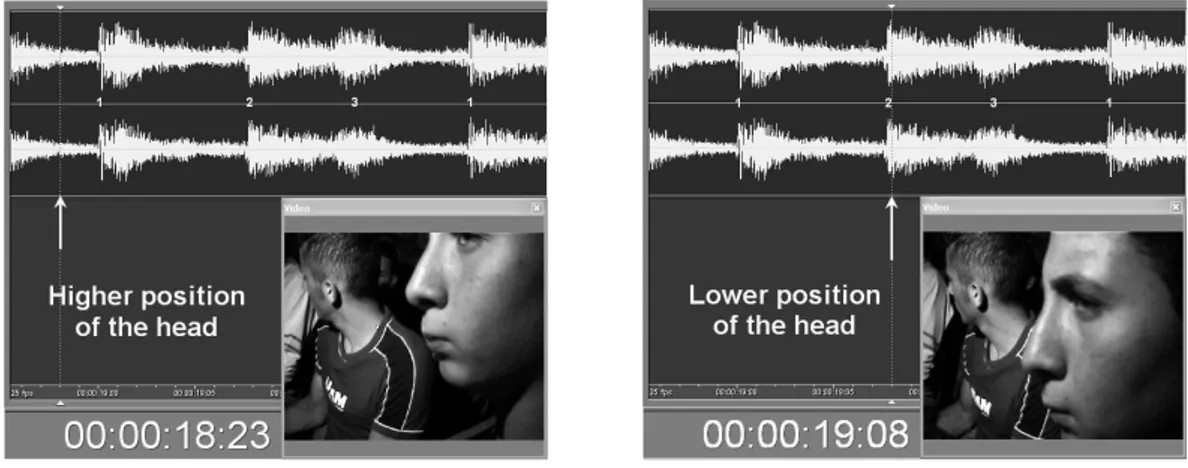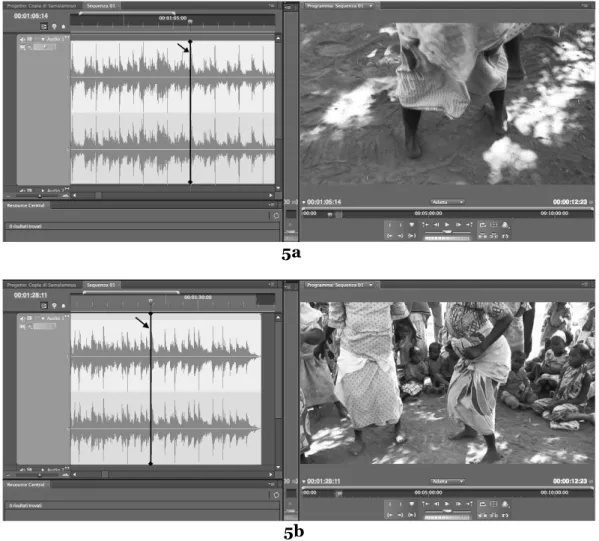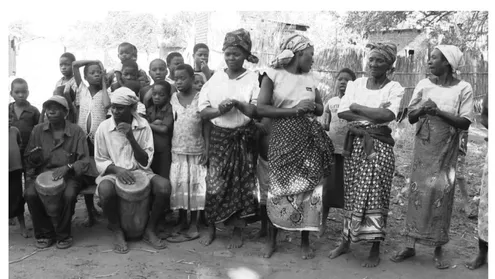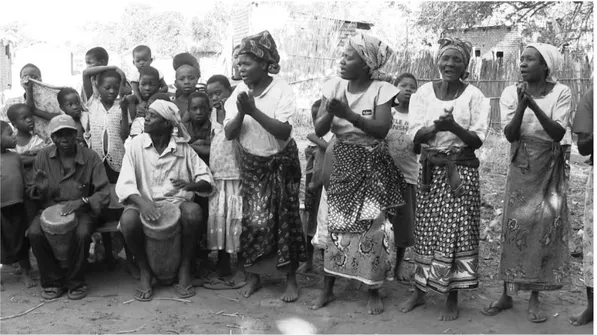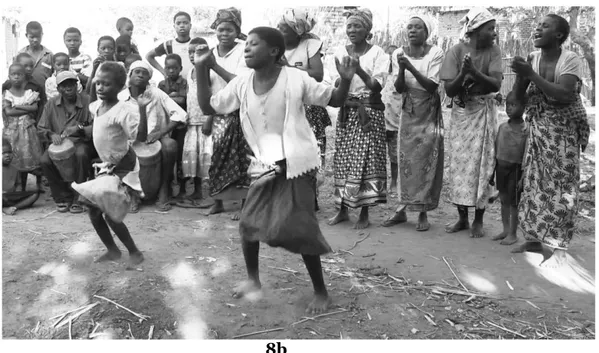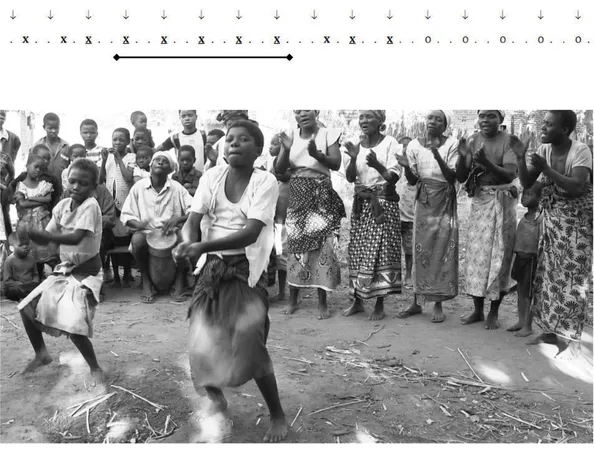Music in the Body:
Video Research in Central and Southern Malawi
(2008-2011)
Giorgio Adamo
In July 2008 and June 2011 I travelled throughout Central and Southern Malawi, together with Dr. Moya A. Malamusi in search of music and dance traditions. I was interested in filming music-making in villages and urban centres where street musicians performed away from the mass media markets and industrial production. The basic aim was to extensively collect video documentation of music and dance repertoires. For many years already, in fact, I have been mainly interested in experiencing methods and techniques of filming music events and exploring examples for a video musical ethnography (Adamo 2010). I was very happy to have the opportunity of travelling throughout Malawi guided by Dr. Malamusi who has great experience in documenting music and dance in Malawi, a deep knowledge of local cultures in Malawi and a very good personal connection with many musical groups and individual musicians.
A more specific aim of my project was to provide material to collect data on the relationship between music and body motion, continuing a project started years ago and based, in its first step, on video field research done in South Italy (see further).
The field research in Malawi has been very successful, producing many hours of audio and video recordings. The region proved to be rich in musical activity away from the entertainment performance areas and recording studios. Among the repertoire groups/genres most documented in the two field trips are:
Ulimba (xylophone) groups with women dancing, especially in the
southern districts of Chikwawa and Nsanje;
Gule Wankulu, the ‘great masked dance’ linked to Nyau secret societies
(see Kubik 1987 and Malamusi 2004);
Manganje dance performed by young guys in order to collect food for the
male circumcision schools moving around neighboring villages
Various dances typical of specific villages or ethnic groups like likhuba,
jiri, beni, m’ganda, nsindo (from Swaziland), ingoma (a Zulu tradition),
usually accompanied by drums or other percussion instruments; Women’s singing with no accompanying musical instrument;
Women’s singing and dancing accompanied by specific rattles (chitzukulumwe);
Banjo groups found in villages or in the urban streets; and
Solo musicians, as guitarists, one-man bands, ngole (bowed lute) players, etc.
Most of the obtained documentation is interesting not only as ethnographic reports on musical life and performing practices but also in terms of the music-body issues. Two particular situations will be examined in this paper: (i) the motional behaviour of women dancing to xylophone group’s performance, and
(ii) the rhythmic structure of the likhuba dance with its complex relationship between singing, hand-clapping, drumming and dancing.
Case Study 1 - Analysis of synchronization patterns: dancing to Samalamoyo Band
In a previously published paper (Adamo 2008) I presented an analysis of the relationship between body motion and musical rhythm in the case of a south Italian dance, tarantella. In that case, two kinds of movements were considered: body movements by music performers, both directly and not directly involved in the production of sound, and movements of the dancers, including dance steps and movements of other parts of the body. A specific technique of frame-by-frame analysis in the digital domain was set up and used in order to connect each video frame to a specific point in the sound waveform: using this procedure it was possible to connect a specific position assumed by a part of the body (a foot, a hand, etc.) during a movement to a given point in the sound timeline. The general principle of frame-by-frame analysis of musical performance dates back to Gerhard Kubik’s analysis of music performances filmed on 8mm silent films (frame by frame) in order to make musical transcriptions: that is, identifying a sound in a xylophone performance isolating visually the strokes on the slats (Kubik 1972). In my case, the same method is extended to a different question: the synchronization between movements and sound events not necessarily depending physically on those movements (as in the case of dance steps); therefore, the need to analyze movement and sound at the same time. Such need can be satisfied in the digital domain using editing software that display at the same time the sound waveform and the video sequence so that it is possible to locate each video frame in the sound timeline. In Figure 1 (below) it is possible to look at an example taken from the above mentioned paper (Adamo 2008:59).
1a 1b
Figure 1a-b. Example of frame-by-frame motion analysis in relation to the sound waveform. The arrow indicates the points of the waveform corresponding respectively to the higher and the lower position of the head during the up and down movement of an organetto (diatonic accordion) player. The higher position is reached near the beat (number 1 in the sequence of three percussion strokes), while the lower position is reached in synchronous time with the second stroke, an upbeat within the 3-stroke rhythmical pattern. The time lag between the two points is 200ms.
The research on south-Italian tarantella as performed in a given area of Calabria provided some interesting and in part unexpected results. One could have expected that the movement of the body of an instrument’s player while playing music and that of a dancer jumping on the fast rhythm of the tarantella would have been synchronized with the upbeat-beat sequence in such a way that the body - or a part of it - is “up” on the upbeat and “down” on the beat. In fact, the synchronization pattern is mainly reversed: for example, the musical beat coincides with the end of the jump of a dancer, that is when its body is “up”, or, as we see in Figure 1, the head of an accordion player who is moving his body while playing, is “up” on the beat and “down” on an upbeat. My interpretation was that rhythm in the body must be considered, at least in this case, in terms of muscular tension and relaxation: on the upbeat we have the greatest muscular tension, which occurs when the dancer is resting on the ground starting a jump, while the beat coincides with the relaxation that occurs at the end of the jump, when the dancer is suspended in the air.
Dancing to Samalamoyo Band
The Samalamoyo Jazzband, as they call themselves, is a group of musicians living in Khungubwe Village, T.A. Ngowe, Chikwawa District, in southern Malawi. The ulimba, the 24-key gourd-resonated xylophone, is usually played by three musicians, accompanied by a drum and a rattle player. When I first filmed this music in the village in July 2008, a group of women started to dance spontaneously in front of the instrumentalists. Here I present some analysis of the movement of these women while they danced.
In Figure 2 (below) we may see the position of the body of two dancing ladies while walking in a circle. Figure 2a shows the frame with the highest position of the body, which coincides exactly, as we see in the waveform on the left, with a stroke on the beat, emphasized in the picture with a black vertical line and an arrow. The beat is easily visible in the waveform because of the very high peaks corresponding to the regular strokes of the drum (we can count 8 peaks in this time-window). Figure 2b shows the lowest position of the body, which falls in the middle, between two strokes on the beat, ca. 200ms later.1 The difference in the position of the body can be detected observing the distance between the head of the dancers and the upper margin of the frame.
We may check now what is happening in the footsteps. Figure 3a shows the position of the feet on the beat: we find the two dancers in the middle of a step: the one in the foreground, in front of us, has the left foot resting on the ground and the right one lifted up, corresponding to the “high” position of the body seen above… while the woman behind her has, consistently, the right foot resting and the left one still lifted up. Figure 3b shows how between two strokes of the drum, corresponding with an accented upbeat, both dancers have the right foot resting on the ground, with the leg slightly bent, corresponding with the “lowest” position
1 The time lag between the two points is 10 frames, that is, in 25 frames per second PAL
format, 400ms, but these analyses are performed on 50% speed slow motion sequences obtained by the separation of each of the two fields forming the frame. By this way 25 frames correspond to half a second of real time, therefore 10 frames to 200ms (see Adamo 2008 for a discussion of the matter).
of the whole body, while the left foot is starting the movement (the first dancer is walking alternating the feet while the one in the background is moving at this point a double step with the same foot).
2a
2b
Figure 2a-b. Position of the body of two dancing ladies while walking in circle. Figure 2a shows the frame with the highest position of the body, which coincides exactly, as it is shown on the waveform (left side), with a stroke on the beat, emphasized in the picture with a black vertical line and an arrow. The lowest position of the body falls in the middle between two strokes on the beat, ca 200ms late
3a
3b
Figure 3a-b. Position of the feet with reference to the beat (walking steps). On the beat (Figure 3a) the dancers have one foot resting on the ground and the other one lifted up, being in the middle of a step. On the upbeat the right foot of both dancers is resting on the ground, with the leg slightly bent corresponding to the “lowest” position of the whole body, while the left foot is starting a new step.
During the walking steps of the dance, therefore, we find a synchronization pattern between movements and musical rhythm which is somewhat similar to the one found in southern Italy, that is maximal muscular tension - starting a footstep, the body being “down” - on the upbeat, maximal relaxation - when the lifted up foot is going back to the ground and the body is “up” - on the beat. After a while the ladies start to perform a different step, a lateral one accompanied by an opposed lateral movement of the pelvis. In Figure 4a (below) we see the pelvis to the left (end of the lateral movement) on the beat, while in Figure 4b, on the upbeat, the pelvis has moved to the right side. The motion pattern can be described this way:
- the direction of the lateral walking is to the right
- on the beat: left foot on the ground, right foot moving towards right (lifted up, in the middle of a movement), pelvis reaching the left position (at the end of the movement)
- on the upbeat: right foot on the ground, left foot moving towards right, pelvis at the end of the movement towards right
4a
4b
Figure 4a-b. Position of the pelvis with reference to the beat. The pelvis reaches the left position on the beat (Figure 4a) and the right position on the upbeat (Figure 4b).
In Figure 5a (below) we see, on the beat, the right foot still moving towards right, while in Figure 5b we see in the same frame how the ladies have the pelvis to one side and the opposite foot lifted up and moving.
In this case, summarizing, we have a more complex synchronization pattern, since there are two movements with a different phase. The pelvis has a motion pattern left-right-left-right where one position is reached on the beat and the opposite on the upbeat. The phase of the feet’s movement is shifted so that the position on the ground is reached while the pelvis is moving and vice versa, the foot is moving when the pelvis is on one side. In my opinion, the shifting between
the two body movements is mainly due to physiological constraints. But it is probably a cultural choice to decide what movement has to be in phase with the beat, or better, in phase with the movement of the music players who are, in this case, emphasizing the beat: actually here the pelvis is apparently moving in phase with the arm of the drummer and the hands of the rattle player.
5a
5b
Figure 5a-b. Relationship between movement of feet and pelvis. Figure 5a shows the right foot lifted up on the beat, moving towards right. In Figure 5b we see how on the beat the dancers have the pelvis on one side (and of the movement) and the opposite foot lifted up and moving.
Case Study 2 - Analysis of music-dance performance: Likhuba
Likhuba is a dance performed by women of different ages, including girls, in
Chipolopolo Village, T.A. Chapananga, Chikwawa District. It is a dance for entertainment where several women alternate as solo performers or as a couple. The music-dance performance is very complex and the following elements are in relation to each other:
- singing by the women, in form of call and response - hand clapping
- dance steps and body movement
The first step in the analysis has been the identification of the beat, the cycle and the elementary pulses (see Kubik 2010: 1-81). Taking into account all the four elements mentioned above, I identified a cycle of 48 elementary pulses, organized as 16 metrical units of three pulses. The beat coincides with the basic hand clapping at the beginning of each song, before the complex hand clapping patterns come into play, and with the strokes of the left hand of the drummer playing the small mbandambanda drum, whose role is to keep steady the same percussion pattern throughout the performance. The relationship between this drum and the basic hand clapping can be seen in Table 1 and in Figure 6.
Figure 6. The basic clapping on the beat by the women coincides with a stroke of the left hand of the mbandambanda drummer seen on the left.
After a while a first complex rhythmic pattern is played by the women. This one is the pattern which characterizes the likhuba dance, and is also called likhuba. It has been very difficult to understand the structure of this pattern, and only the slow motion and the frame-by-frame video analysis has shown the real relation of this pattern to the beat. The key point is that the first clap in the pattern is not on the beat but coincides with the right hand’s after-beat stroke of the
mbandambanda drummer, as we may see in Figure 7. The whole pattern can be
The dance steps are perfectly synchronized with the handclapping. One of the
dance patterns, for example, translating the hand’s pattern into body motion, is
shown in Table 3, where we can see in which point the left (L) and right (R) foot
stamp the ground while jumping, sometimes together (LR), sometimes one after
the other (L or R). In this case the legs of the dancers are behaving exactly as the
arms of the clapping ladies or the hands of the drummer, that is the muscular
tension is “anticipated” in order to arrive to the end of the movement in sync with
the strokes and the claps (we see in Figure 8a-b the motion behavior of the
dancers in sync with the first clap of the pattern shown in Table 3).
7a
7c
Figure 7a-c. Frames corresponding to the first three claps in the pattern. The first two claps (Figure 7a and 7b) coincide with an after-beat stroke of the right hand of the mbandambanda drummer (on the left), while the third clap (Figure 7c) coincides with a stroke of the left hand on the beat.
8b
Figure 8a-b. Relationship between jumping, hand clapping and mbandambanda drum. Figure 8a shows the two young dancers off the ground while the two hands of the clapping ladies are starting a clap and the right hand of the drummer is also lifted up getting ready to start a stroke. In Figure 8b, ca. 160ms later, the dancers are back to the ground in sync with the clap and the drummers’ stroke.
There is a second rhythmic pattern performed by hand clapping, which is similar to the first one but with a significant difference in the middle where we find a sequence of claps on the beat, while the beginning and the end of the two patterns are the same. We can see in Table 4 a comparison between the two patterns.
Also, the second hand clapping pattern is perfectly represented through synchronous steps and body motion patterns by the dancers. And the big drum too is played consistently with one or the other pattern. One big question is still open: According to what criteria do the dancers, the hand clapping women and the player of the big drum change between the two patterns? For an observer it is absolutely unpredictable what pattern will be performed, suddenly there is a change from one to the other in all the three components at the same time: clapping, dancing and drumming. Even interviews with the performers, conducted in Chichewa by Moya A. Malamusi, have not yet solved the question, but there are hints that the pattern to be performed is determined by the words in
the song. For example, a motion pattern played by the dancers - especially by young girls - moving rhythmically both arms upwards, joining the two hands, synchronous with a five-clap sequence in the second clapping pattern (see Table 5 and Figure 9), has clearly a symbolic meaning that the ladies didn’t want to explain, being probably in connection with sexual life and children initiation (sometimes, when this movement is performed all the children around burst out laughing). It is possible that this motion (and musical) pattern is “called” by the song.
Figure 9. The two dancing girls are moving rhythmically with both arms upwards, joining the two hands, synchronous with the five-clap sequence in the second clapping pattern (see Table 5).
What I have presented here are my first results of a work in progress. There are still aspects to investigate in order to get a good knowledge of how a likhuba music-dance works. In particular, I’m planning to devote further attention, through video analysis and new fieldwork, to the following topics: (i) the role of the big drum (gunda) and its close relationship with hand clapping and dance movements; (ii) the role of singing, both on the musical and semantic level; (iii) the differences between different songs. But certainly, the video analysis presented here has in my opinion definitely contributed to a basic understanding of the music-dance structure
.
Final Remarks
As we have seen, the video documentation allows an analysis of how a musical rhythm is translated into body motion. At the same time, an analysis of body movements and motion patterns can help understanding music structures. In the case of the women’s dancing to Samalamoyo ulimba group, we have provided a confirmation that what was previously found in a south Italian dance - that is a kind of non-linear synchronicity between movement and rhythm due to a translation of acoustical rhythm into muscular tension-relaxation patterns - can occur even in other cultures. In the case of the likhuba dance, the analysis of video documents has proved to be a powerful tool to reveal the role of different elements in a complex music-dance performance and their reciprocal relationship, while the model of synchronicity between dance movements and the musical beat appears to be different from the one identified in the other contexts. The music-body-motion connection and its way to manifest itself is probably depending on both natural and cultural factors. Combining ethnographic research and comparative approach can help in understanding how physiological mechanisms and constraints combine with cultural choices.
References
Adamo, Giorgio. 2008. Music – Body – Movement. An “African” perspective
applied to the analysis of South Italian dances, in African Perspectives: Pre-Colonial History, Anthropology, and Ethnomusicology, ed. by Regine
Allgayer-Kaufmann and Michael Weber, Frankfurt Am Main, Peter Lang: 49-70 (with video examples on DVD).
_____2010. Vedere la musica. Film e video nello studio dei comportamenti
musicali, Lucca, LIM (with DVD).
Kubik, Gerhard. 1975. Transcription of African music from silent film: theory
and methods, «African Music» 5/2: 28-39.
_____1987. (in collaboration with Moya A. Malamusi) Nyau –
Maskenbünde im südlichen Malawi, Wien, Verlag der Oesterreichischen
Akademie der Wissenschaften.
_____2010. Theory of African Music, vol. II, Chicago, University of Chicago Press.
Malamusi, Moya A. 2004. The Nyau Masking Tradition in Central and Southern
Malawi. Field Observations 1983-2003 on Meanings, Social Context and Recent Developments. Ph.D. Dissertation, Institut für Ethnologie,
